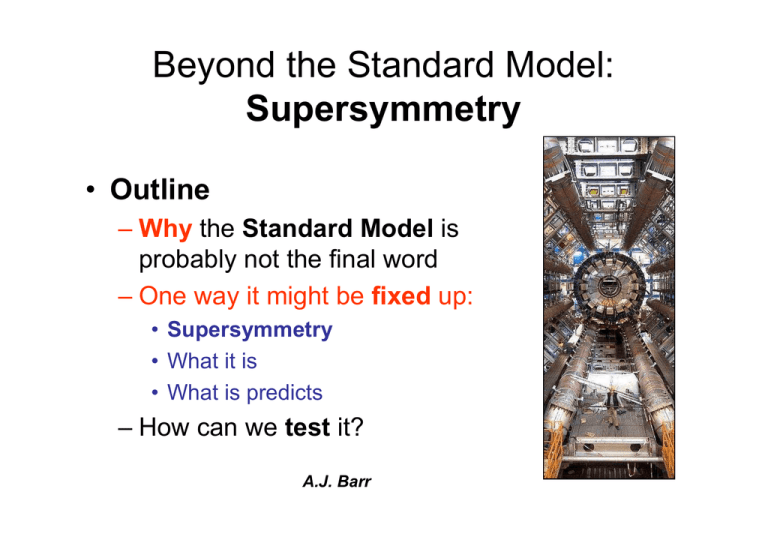Document
advertisement

Beyond the Standard Model:
Supersymmetry
• Outline
– Why the Standard Model is
probably not the final word
– One way it might be fixed up:
• Supersymmetry
• What it is
• What is predicts
– How can we test it?
A.J. Barr
Preface
• Standard Model doing very well
– Measurements in agreement with predictions
– Some very exact: electron dipole moment to
12 significant figures
• However SM does not include:
– Dark matter
• Weakly interacting massive particles?
– Gravity
γ
e
e
All QED contributions
to dipole moment
with ≤ four loops
calculated
• Not in SM at all
– Grand Unification
• Colour & Electroweak forces parts of one
“Grand Unified” group?
– Has a problem with Higgs boson mass
Should
Shouldexpect
expectto
tofind
findnew
newphenomena
phenomenaat
athigh
highenergy
energy
Higgs boson mass
• Standard Model Higgs boson mass:
114 GeV < mH <~ 1 TeV
Direct searches at “LEP”
e+e- collider
e-
e+
h
WW boson scattering partial
wave amplitudes > 1
W
Z0
Experimental search
W
W
W
“Probabilities > 1”
(compare Fermi model of weak interaction)
More on mH …
Measured W mass depends on mH
Fit to lots of data
(including mW)…
H
W
W
W
W emits & absorbs virtual
Higgs boson
changes propagator
changes measured mW:
∆ H mW
m H2
∝ mW ln 2
mW
log dependence on mH
… mH lighter than about 200 GeV
Higgs
Higgs mass
mass is
is same
same order
order as
as W,
W, ZZ bosons
bosons
Corrections to Higgs Mass?
H
The top quark gets its mass
by coupling to Higgs bosons
λ
t
t
t
λ
H
λ
_
t
H
Similar diagram leads to a change
in the Higgs propagator
change in mH
Integrate (2) up to loop momentum ~ ΛUV
2
λ
2
2
∆mH = − 2 Λ UV
8π
Changes of order ΛUV
Maximum energy at which
we think existing theory
(SM) is valid
Fixing the Higgs mass
Problem:
t
λ
λ
_
H
mGUT ~ 1016 GeV
H
∆mH ~ ΛUV
hc
mPl =
~ 1019 GeV
G
t
Fermion loop
mH (true) = mH (bare) + ∆mH
needs extraordinary cancellation
“Fine tuning” of mH (bare)
Fix:
Spin-0 particle
λ
H
λ
H
Need
Neednew
newpartner
partner∆s
∆s==½
½
to
tocancel
canceleach
eachSM
SMparticle
particle
λ2 2
∆m = − 2 Λ UV
8π
2
H
Cancel this correction?
Boson loop opposite correction:
2
λ
∆mH2 = + 2 Λ2UV
8π
Same coupling as top
New spin-0 particle
Supersymmetry
• Nature permits only
particular types of
symmetry:
(1) Space & time
• Lorentz transforms
• Rotations and
translations
(2) Gauge symmetry
• Such as Standard Model
force symmetries
• SU(3)c x SU(2)L x U(1)
(3) Supersymmetry
•Anti-commuting generators:
{Qr , Qs } = 2γ rsµ Pµ
{A,B} ≡ AB + BA
•Q changes Fermion into
Boson and vice-versa:
Symbolically:
Symbolically:
QQfermion
fermion
boson
boson
QQboson
boson
fermion
fermion
Equal
Equalnumbers
numbersof
ofbosonic
bosonic&&fermionic
fermionicdegrees
degreesof
offreedom
freedom
Precisely
Preciselywhat
whatisisneeded
neededto
tofix
fixHiggs
Higgsmass
massproblem
problem
(S)Particles
Standard
Model
Spin-1/2
Spin-1
Spin-0
quarks (L&R)
leptons (L&R)
neutrinos (L&?)
γ
Z0
W±
gluon
h0
H0
A0
H±
B
W0
Supersymmetric
partners
squarks (L&R)
sleptons (L&R)
sneutrinos (L&?)
Bino
Wino0
Wino±
gluino
Spin-0
After
Mixing
4 x neutralino
Spin-1/2
~
H0
~
H±
gluino
2 x chargino
(Higgsinos)
Extended higgs sector
2 complex doublets 8-3 = 5 Higgs bosons
Two complications
m(e~ ) = m(e)
No partners yet observed
up to m ~ 100 GeV
Expect masses ~ TeV
fine tuning problem
u
u
_
~
s
Pion
If exact would have
Proton
Supersymmetry is a
broken symmetry
Unrestricted supersymmetry
fast proton decay
_
u
d
e+
For stable protons need
conservation of:
RP = (-1)3B+L+2S
RP =
+1 SM particles
-1 SUSY particles
Do we really need to double
the particles?
• Lightest SUSY particle
can easily be:
– Uncharged
– Stable
Why
Whystable?
stable?
– Massive
• Good dark matter
candidate
Visible mass
Invisible mass
Bullet cluster
Adding Supersymmetry also helps with
- Grand Unification
- Electroweak symmetry breaking
Supersymmetry
Supersymmetrysolves
solvesaalot
lotof
ofproblems
problems
Finding Supersymmetry
• Direct search
• Precision
experiments
E.g. LEP, Tevatron, LHC
colliders
q
~
q
g
~0
E.g. magnetic moment
of the muon:
+
µ
µ
χ
γ
γ
µ~
µ
µ~
χ~ 0
Currently expt not quite in
agreement with S.M.
prediction
g
µ
q~
q
χ~ 0
Produce heavy particles
which then decay
Why
Whyproduced
producedin
inpairs?
pairs?
Mass/GeV
• Complicated
cascade decays
– Many
intermediates
• Typical signal
– Jets
• Squarks and
Gluinos
– Leptons
• Sleptons and weak
gauginos
– Missing mmtm
“Typical” SUSY spectrum
• Undetected
Lightest SUSY
Particle
Simulated SUSY event
Jets
Missing transverse momentum
Heavy quarks
Leptons
After finding a Higgs boson…
• Discover Supersymmetry
– Backgrounds?
• Measure sparticle masses
– Probe SUSY breaking mechanism
• Measure sparticle spins
– Show that they differ by ½ unit from SM
• Find the other four Higgs bosons
– Supersymmetry requires five
Go hunting …
More…
• SUSY primer: S.P. Martin
http://arxiv.org/abs/hep-ph/9709356
